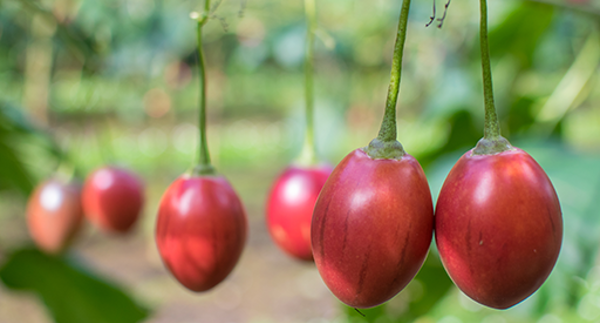
5 Steps to Tamarillo Success
- Choose a spot in full sun except in very hot areas, where partial shade is preferable.
- Prepare your soil with organic matter like compost and sheep pellets.
- Tamarillos are best planted in late autumn or early spring in New Zealand as they are frost tender, tolerating light frost once established.
- Feed well in the growing season as tamarillos are fast growing trees.
- Mulch and water well, particularly over the growing season.
Follow our full guide below to a bumper crop of homegrown tamarillos.
Soft, juicy and sweet yet tart, tamarillo will fruit over a long season - through late winter and well into spring - making it perfect for growing at home.
Fresh, ripe tamarillos are best eaten cut in half lengthwise, sprinkled with sugar and chilled, then eaten by scooping out the pulp with a spoon. Formerly called a tree tomato because of it's subtle similarities, the tamarillo is actually more closely related to the guava. They're originally from South America but have become widely grown and very well known in New Zealand.
PREPARE
Plant in a well drained soil as tamarillo do not like heavy, waterlogged soil. Dig in as much nutrient rich organic matter as you can, such as Tui Compost and Tui Organic Sheep Pellets, this is especially important for sandy soils. Plant trees in a sheltered position and stake the tree to protect from wind as branches are very brittle and break easily.
Top varieties for the home garden:
There are a few different varieties in New Zealand with the dark purple or red skinned tamarillos tending to be more popular because of their brighter colours. The red fruiting varieties are often more acidic and the yellow fruit less acidic.
Ted's Red: Big red, round fruit with an acidic flavour.
Oratia Red: Large, red oval or round fruit with a sharp acid flavour. Excellent for jams and preserves, as well as eating fresh.
Tango: Reddish-orange fruit with a sweet flavour and less acidity.
PLANT
Check plant labels for individual planting instructions. The best times to plant are early in the morning or late in the day, so the plants aren’t exposed to the hot sun straight away.
Tamarillo grow best in full sun but if the area is too hot and prone to drying out, then partial shade is needed. The best time to plant is in late autumn or early spring when the risk of frost has passed.
Being a suptropical species, they do not like cold and blustery conditions which means they are normally grown in the warmer parts of the country. They need warm summer and mild winter growing temperatures as they are frost tender, but once established tamarillo will tolerate light frost. Usually evergreen, they will drop their leaves in winter in cooler climates, however they will grow in greenhouse conditions or frost-free areas in these places.
Stake trees at the time of planting as wind can be damaging.
They can also be grown in pots and containers if they are kept well watered during the growing season.
Tamarillo are self fertile so don’t require a pollinator – their flowers are pollinated by insects and bees, as well as the wind.
Companion planting French marigolds around the tamarillo tree will help deter whitefly, which can be a problem in summer.
NOURISHING
Feed your plants and they will feed you. Tamarillo do a lot of growing in a short space of time so replenishing nutrients ensures they will grow to their full potential. They will benefit from regular feeding throughout the growing season - use Tui Citrus Food or Tui Novatec Premium Fertiliser in early spring, summer and autumn.
Tamarillo have a very shallow root system and don't like competing with weeds or other plants for nutrients and moisture. Weeds also harbour pests and diseases. Keep well watered during the growing season and mulch around the tree with a quality mulch such as Tui Pea Straw or Tui Mulch & Feed. This will keep weeds down as well as retain soil moisture and add organic matter to the sandy soils.
Tamarillo will not stand for drought, but they are also intolerant of excess moisture so well-draining soil is essential. Standing in water for even a few days can kill the plant.
Protect your tree in winter by mulching around the base of the tree before the first frost. If mulch is applied after frosts arrive it insulates the soil which will stay cold.
Harvesting
Tamarillo trees take about 2 years to produce fruit, and will then be productive for around 10 years.
Fruit will ripen any time from April to November, and can take 8 months from pollination to ripening. They're ready to harvest when they develop their colour and should be cut from the tree with the stalk still attached.
If left to ripen 1-3 weeks after picking they will become less acidic. Tamarillo can be stored for 2-3 weeks in a cool, draught-free place, or up to 6 weeks in the fridge
Tamarillo are great for preserving in jars, or the flesh can be pureed then frozen.
Pruning
Tamarillo fruit on new season's growth so it is important to prune at the end of each season after fruiting has finished, and when the risk of frost has passed. They also have brittle branches. Grow to 1-1.5m then take the top out of the tree to encourage branching. When the branches get to approximately 50cm long take the tips out to keep fruit towards the centre of the tree rather than further out along the branches which could break under the weight of the fruit.